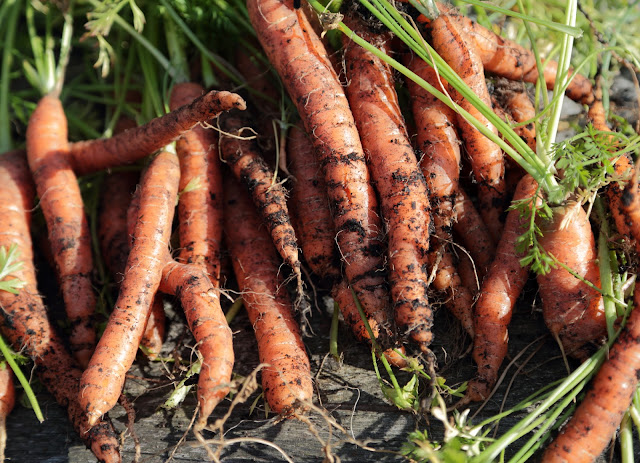It was a great few hours - chatting to my friend as we picked blackcurrants, sorted and tied up onions, weeded and raked, fed and sowed the bed with turnips, perpetual spinach, beetroot and more carrots.
My friends had success with runner beans last year. This year, they are growing a pretty, buttery-flowered variety, fading to white, but it's been wet, dull, cool, and the plants have been covered in slugs - the biggest I've ever seen. Nonetheless, they survived, and have started producing pods. Small pots of sweet peas, on either side, gave a modest posy of cut flowers - large, white, the edges tinged with lilac.
Blackcurrants! There are two patches in this garden, both many years old. I did some remedial pruning in the spring, but otherwise they've been left alone - still they have produced a large, healthy crop. It took a couple of hours for us to pick them all - sticky work, but worth it. Before I left, we made a bottle of cassis - simply breaking down a small bowlful of fruit in a pan with a dash of water, passing through a sieve, adding sugar and alcohol (white rum as it was to hand) to taste. The rest were frozen on trays, so they can be bagged up and kept for later use.
When I tested the carrot crop two or three weeks ago, I was not impressed - they seemed small, forked, and some were nibbled (slugs had taken off the exposed tops). I left them in the ground, since we had nothing to lose, and I hoped they might swell a little more, but by yesterday I was anxious to get the ground resown with something I hoped would be more successful. What a surprise - the bed was full of carrots, many straight(ish), reasonably thick, unblemished, and fragrant. I took a bagful, and my friends got even more. So this is my first true carrot crop, after years of failing. Not as regular in appearance as supermarket examples, but they have an intense aroma that is unbeatable.
You may recall I sowed some red basil back in the spring. My friends have diligently potted them on and kept them watered, and now they are in full bloom - so they are at the end of their productive life (although there's still time to sow a fresh crop), but they filled the greenhouse with scent, and were beautiful enough to have been used as bedding plants. The foliage has gone an interesting two-tone purple and lime green combination, and they are topped by tall spikes of pale purple flowers, which would attract pollinators if they were outdoors. I took some leaves, which should be tender and fragrant enough to eat.
The onions were a reasonable success too. For £1, we got around 40 sets, and most have swollen into medium-sized bulbs. One or two had flowered, reducing their size, but the best were hung up to dry in my friends' shed. It's a good idea to 'cure' them like this, somewhere airy and out of the rain, if you want to keep them for a long time. The leaves with shrivel, the outer skin will go papery, and they should enter dormancy. They are perfectly edible now, of course. Note, the onions I planted in the shadier raised bed (below) are still growing, so I've left them in for now.
My friends' garden has some old fruit trees, which tend to produce a harvest only every other year at best. The smaller apple tree is currently laden with blushed fruits (above), while the larger tree, which yielded a very tasty if bone-dry cider two years ago is having an identity crisis, producing spurs of blossom in July, while a generous crop of fruits swells around them (below).
Finally, there are crops still to come, like blackberries. The brambles above are very well behaved, arching over a boundary wall, and gave a handful of ripe fruits yesterday - the first to ripen is always the one at the tip of the spur. There should be a good-sized crop, so long as it doesn't rain too much over the next few weeks.









No comments:
Post a Comment